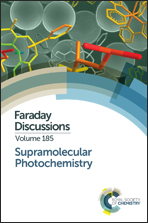Quantifying the formation of chiral luminescent lanthanide assemblies in an aqueous medium through chiroptical spectroscopy and generation of luminescent hydrogels†
Abstract
Herein we present the synthesis and the photophysical evaluation of water-soluble chiral ligands (2·(R,R) and 2·(S,S)) and their application in the formation of lanthanide directed self-assembled structures. These pyridine-2,6-dicarboxylic amide based ligands, possessing two naphthalene moieties as sensitising antennae, that can be used to populate the excited state of lanthanide ions, were structurally modified using 3-propanesultone and caesium carbonate, allowing for the incorporation of a water-solubilising sulfonate motif. We show, using microwave synthesis, that Eu(III) forms chiral complexes in 1 : 3 (M : L) stoichiometries (Eu·[2·(R,R)]3 and Eu·[2·(S,S)]3) with these ligands, and that the red Eu(III)-centred emission arising from these complexes has quantum yields (Φtot) of 12% in water. Both circular dichroism (CD) and circular polarised luminescence (CPL) analysis show that the complexes are chiral; giving rise to characteristic CD and CPL signatures for both the Λ and the Δ complexes, which both possess characteristic luminescence dissymmetry factors (glum), describing the structure in solution. The self-assembly process was also monitored in situ by observing the changes in the ligand absorption and fluorescence emission, as well as in the Eu(III) luminescence. The change, fitted using non-linear regression analysis, demonstrated high binding affinity for Eu(III) which in part can be assigned to being driven by additional hydrophobic effects. Moreover, using CD spectroscopy, the changes in the chiroptical properties of both (2·(R,R) and 2·(S,S)) were monitored in real time. Fitting the changes in the CD spectra allowed for the step-wise binding constants to be determined for these assemblies; these matched well with those determined from both the ground and the excited state changes. Both the ligands and the Eu(III) complexes were then used in the formation of hydrogels; the Eu(III)-metallogels were luminescent to the naked-eye.
- This article is part of the themed collection: Supramolecular Photochemistry

 Please wait while we load your content...
Please wait while we load your content...